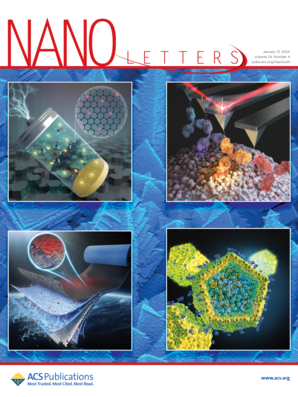In Situ Multiscale Study of Iron Oxidation at High Temperatures
IF 9.6
1区 材料科学
Q1 CHEMISTRY, MULTIDISCIPLINARY
引用次数: 0
Abstract
Although high-temperature oxidation of metals results in significant failure of structure materials, in situ understanding of these processes and developing improved strategies are still very limited. Herein, using environmental scanning electron microscopy (ESEM), environmental transmission electron microscopy (ETEM), and X-ray photoelectron spectroscopy (XPS), we report the in situ dynamic high-temperature oxidation behaviors of iron in O2, H2O, and O2 + H2O atmospheres, respectively. The results demonstrate that an oxygen-rich environment (1.6 mbar) leads to transient formation of polycrystalline Fe3O4 without passivation effects on further oxidation, while sparse oxygen environments (10–3 mbar) promote formation of a uniform thin passivation layer of Fe3O4, protecting itself from further oxidation in ambient air. In contrast to O2, the H2O vapor accelerates oxidation, and the products consist of Fe3O4 and FeOOH. These in situ results give insights into designing technically universal antioxidation strategies.

高温下铁氧化的原位多尺度研究
尽管金属的高温氧化会导致结构材料的严重破坏,但对这些过程的现场理解和开发改进策略仍然非常有限。本文利用环境扫描电镜(ESEM)、环境透射电镜(ETEM)和x射线光电子能谱(XPS)技术,分别报道了铁在O2、H2O和O2 + H2O气氛下的原位动态高温氧化行为。结果表明,富氧环境(1.6 mbar)可瞬间形成多晶Fe3O4,对进一步氧化无钝化作用,而稀氧环境(10-3 mbar)可促进Fe3O4形成均匀的薄钝化层,保护其在环境空气中不被进一步氧化。与O2相比,H2O蒸汽加速氧化,产物由Fe3O4和FeOOH组成。这些原位结果为设计技术上通用的抗氧化策略提供了见解。
本文章由计算机程序翻译,如有差异,请以英文原文为准。
求助全文
约1分钟内获得全文
求助全文
来源期刊

Nano Letters
工程技术-材料科学:综合
CiteScore
16.80
自引率
2.80%
发文量
1182
审稿时长
1.4 months
期刊介绍:
Nano Letters serves as a dynamic platform for promptly disseminating original results in fundamental, applied, and emerging research across all facets of nanoscience and nanotechnology. A pivotal criterion for inclusion within Nano Letters is the convergence of at least two different areas or disciplines, ensuring a rich interdisciplinary scope. The journal is dedicated to fostering exploration in diverse areas, including:
- Experimental and theoretical findings on physical, chemical, and biological phenomena at the nanoscale
- Synthesis, characterization, and processing of organic, inorganic, polymer, and hybrid nanomaterials through physical, chemical, and biological methodologies
- Modeling and simulation of synthetic, assembly, and interaction processes
- Realization of integrated nanostructures and nano-engineered devices exhibiting advanced performance
- Applications of nanoscale materials in living and environmental systems
Nano Letters is committed to advancing and showcasing groundbreaking research that intersects various domains, fostering innovation and collaboration in the ever-evolving field of nanoscience and nanotechnology.
 求助内容:
求助内容: 应助结果提醒方式:
应助结果提醒方式:


